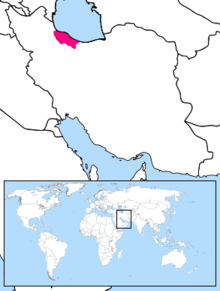Gileki language
| Gilaki | |
|---|---|
| گیلکی Giləki | |
| Native to | Iran, province of Gilan and parts of the province of Mazandaran and Qazvin |
| Region | Southwest coast of the Caspian Sea |
|
Native speakers
|
4 million (2006) 3.3 million (1993) |
| Dialects |
|
| Language codes | |
| ISO 639-3 | |
| Glottolog | gila1241 |
| Linguasphere | 58-AAC-eb |

Areas where Gilaki is spoken as the mother tongue
|
|
4 million (2006)
The Gilaki language is a Caspian language, and a member of the northwestern Iranian language branch, spoken in Iran's Gīlān Province. Gilaki is closely related to Mazandarani and the two languages have similar vocabularies. The Gilaki and Mazandarani languages (but not other Iranian languages) share certain typological features with Caucasian languages (specifically South Caucasian languages), reflecting the history, ethnic identity, and close relatedness to the Caucasus region and Caucasian peoples of the Gilaki people and Mazandarani people.
The language is divided into three dialects: Western Gilaki, Eastern Gilaki, and Galeshi (in the mountains of Gilan). Furthermore, the Gilaki language is closely related to Mazanderani, and the two languages have similar vocabularies.The western and eastern dialects are separated by the Sefid River. According to Ethnologue, there were more than 3 million native speakers of Gilaki in 1993. By 2006 there were 4 million native speakers of Gilaki.
There are three main dialects but larger cities in Gilan have slight variations to the way they speak. These "sub-dialects" are Rashti, Rudbari, Some’e Sarai, Lahijani, Langerudi, Rudsari, Bandar Anzali and Fumani.
A slightly differente style of Gilaki (eastern dialect) is spoken in the city of Ramsar, Mazandaran. The dialect has been influenced by the Mazandarani language and is sometimes referred to as Mazandarani-Gilaki although most refer to it as Ramsari.
...
Wikipedia
